Related Research Articles

John Chrysostom was an important Early Church Father who served as archbishop of Constantinople. He is known for his preaching and public speaking, his denunciation of abuse of authority by both ecclesiastical and political leaders, his Divine Liturgy of Saint John Chrysostom, and his ascetic sensibilities. The epithet Χρυσόστομος means "golden-mouthed" in Greek and denotes his celebrated eloquence. Chrysostom was among the most prolific authors in the early Christian Church.
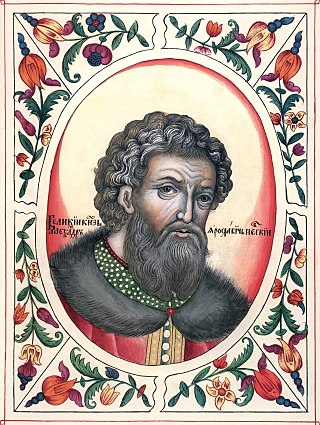
Alexander Yaroslavich Nevsky was Prince of Novgorod, Grand Prince of Kiev (1246–1263) and Grand Prince of Vladimir (1252–1263).
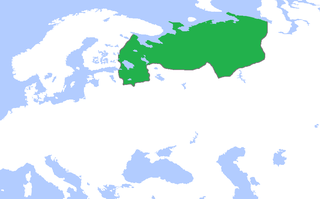
The Novgorod Republic was a medieval state that existed from the 12th to 15th centuries in northern Russia, stretching from the Gulf of Finland in the west to the northern Ural Mountains in the east. Its capital was the city of Novgorod. The republic prospered as the easternmost trading post of the Hanseatic League, and its people were much influenced by the culture of the Byzantines.

The Cathedral of St. Sophia, the Holy Wisdom of God in Veliky Novgorod, Russia, is the cathedral church of the Metropolitan of Novgorod and the mother church of the Novgorodian Eparchy.

Stephen of Perm was a Russian Orthodox bishop, painter and missionary. He is known as being one of the most successful missionaries of the Russian Orthodox Church. Stephen is credited with the conversion of the Komi peoples to Christianity. He settled in Ust-Vym and became the first bishop of Perm in 1383.
The Swedish–Novgorodian Wars were a series of conflicts in the 12th and 13th centuries between the Novgorod Republic and medieval Sweden over control of the Gulf of Finland, an area vital to the Hanseatic League and part of the trade route from the Varangians to the Greeks. The Swedish attacks against Orthodox Russians had religious overtones, but before the 14th century there is no knowledge of official crusade bulls issued by the pope.
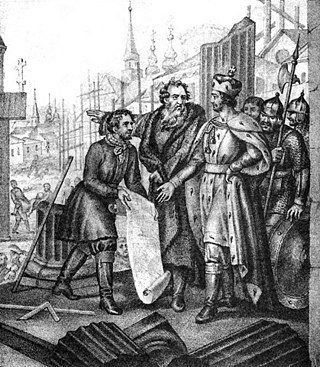
The Finnish–Novgorodian wars were a series of conflicts between Finnic tribes in eastern Fennoscandia and the Republic of Novgorod from the 11th or 12th century to the early 13th century.

Vsevolod Mstislavich Monomakh, the patron saint of the city of Pskov, ruled as Prince of Novgorod in 1117–32, Prince of Pereslavl (1132) and Prince of Pskov in 1137–38.
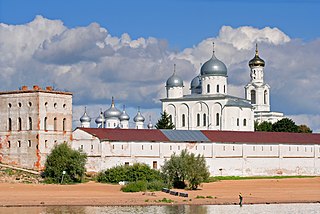
The St. George's (Yuriev) Monastery is usually cited as Russia's oldest monastery. It stands in 5 kilometers south of Novgorod on the left bank of the Volkhov River near where it flows out of Lake Ilmen. The monastery used to be the most important in the medieval Novgorod Republic. It is part of the World Heritage Site named Historic Monuments of Novgorod and Surroundings.

The Prince of Novgorod was the title of the ruler of Novgorod in present-day Russia. From 1136, it was the title of the figurehead leader of the Novgorod Republic.

The Diocese of Novgorod is one of the oldest offices in the Russian Orthodox Church. The medieval archbishops of Novgorod were among the most important figures in medieval Russian history and culture and their successors have continued to play significant roles in Russian history up to the present day. They patronized a significant number of churches in and around the city,, and their artistic and architectural embellishments influenced later Russian art and architecture; they also patronized chronicle-writing, a crucial source on medieval Russian history.
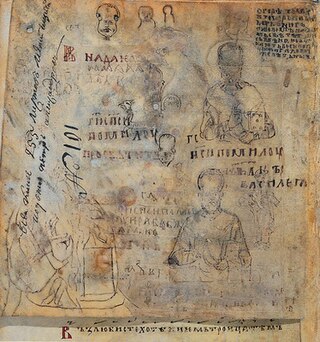
Vasily Kalika was Archbishop of Novgorod the Great and Pskov from 1330 to 1352. He is in large part responsible for reinvigorating the office after it had fallen into decline to some extent following the Mongol invasion. He was canonized as a saint by the Russian Orthodox Church.

The koukoulion is a traditional headdress worn by monks and certain patriarchs in Eastern Christianity.
Daniel the Traveller, known also as Daniel the Pilgrim, Daniel of Kiev, or Abbot Daniel, was the first travel writer from the Kievan Rus. He is known for travelling to the Holy Land in the aftermath of the First Crusade and his descriptions are important records of the region during that time. Some have identified him with a certain Daniel, bishop of Yuryev between 1115 and 1122.

Kievan Rus', also known as Kyivan Rus' was a state and later an amalgam of principalities in Eastern and Northern Europe from the late 9th to the mid-13th century. The name was coined by Russian historians in the 19th century. Encompassing a variety of polities and peoples, including East Slavic, Norse, and Finnic, it was ruled by the Rurik dynasty, founded by the Varangian prince Rurik. The modern nations of Belarus, Russia, and Ukraine all claim Kievan Rus' as their cultural ancestor, with Belarus and Russia deriving their names from it, and the name Kievan Rus' derived from what is now the capital of Ukraine. At its greatest extent in the mid-11th century, Kievan Rus' stretched from the White Sea in the north to the Black Sea in the south and from the headwaters of the Vistula in the west to the Taman Peninsula in the east, uniting the East Slavic tribes.

Veliky Novgorod, also known simply as Novgorod (Новгород), is the largest city and administrative centre of Novgorod Oblast, Russia. It is one of the oldest cities in Russia, being first mentioned in the 9th century. The city lies along the Volkhov River just downstream from its outflow from Lake Ilmen and is situated on the M10 federal highway connecting Moscow and Saint Petersburg. UNESCO recognized Novgorod as a World Heritage Site in 1992. The city has a population of 224,286 (2021 Census).

The donkey walk is a Russian Orthodox Palm Sunday ritual re-enactment of Jesus Christ's entry into Jerusalem. The best known historical donkey walk was practised in Moscow from 1558 until 1693. The Metropolitan and later Patriarch of Moscow, representing Jesus Christ, rode on a donkey, while the Tsar of Russia humbly led the donkey on foot.
Saint Paraskeva of the Balkans was an ascetic female saint of the 10th century. She was born in Epivates, near present-day Istanbul, and had visions of the Virgin Mary. After living in Chalcedon and Heraclea Pontica, she settled in a convent in the desert near the Jordan River, where she died at the age of 27. The cult of Saint Paraskeva began to spread in the 14th century from Bulgaria into the Danubian Principalities of Wallachia and Moldavia. There was confusion over her identity and attributes because her Greek name "paraskevi" means "Friday," and translations in other languages, such as Romanian and Serbian, were "Saint Friday". Her cult continues to be celebrated in many Orthodox countries, and her feast day is commemorated on October 14 in the Eastern Orthodox Church.

Novgorodian Land was one of the largest historical territorial–state formations in Russia, covering its northwest and north. Novgorod Land, centered in Veliky Novgorod, was in the cradle of Kievan Rus' under the rule of the Rurikovich dynasty and one of the most important princely thrones of the era. During the collapse of Kievan Rus' and in subsequent centuries, Novgorod Land developed as the Novgorod Republic: an autonomous state with republican forms of government under the suzerainty of the great princes of Vladimir-Suzdal. During the period of greatest development, it reached north to the White Sea, and in the east it spread beyond the Ural Mountains. It had extensive trade relations within the framework of the Hanseatic League and with the rest of Rus'. Muscovy conquered the Novgorod Republic in 1478, and annexed it in 1578, although Novgorod Land continued to exist as an administrative unit until 1708.
References
- 1 2 Keck, Karen Rae (1998), "Anthony of Novgorod", The Ecole Initiative, archived from the original on 2012-04-07, retrieved 2011-10-21
- 1 2 Walsh, Michael (2007), A New Dictionary of Saints: East and West, Liturgical Press, p. 54, ISBN 0-8146-3186-X
- 1 2 3 Majeska, George P. (2016), "Politics and Hierarchy in the Early Rus' Church: Antonii, a 13th-century Archbishop of Novgorod", Tapestry of Russian Christianity: Studies in History and Culture., retrieved 2019-02-01
- ↑ Geary, Patrick J. (1994), Living with the dead in the Middle Ages, Reference, Information and Interdisciplinary Subjects Series, Cornell University Press, p. 223, ISBN 0-8014-8098-1
- ↑ Karpov, A. Антоний, архиепископ Новгородский [Anthony, Archbishop of Novgorod] (in Russian). www.portal-slovo.ru. Archived from the original on 4 May 2009.